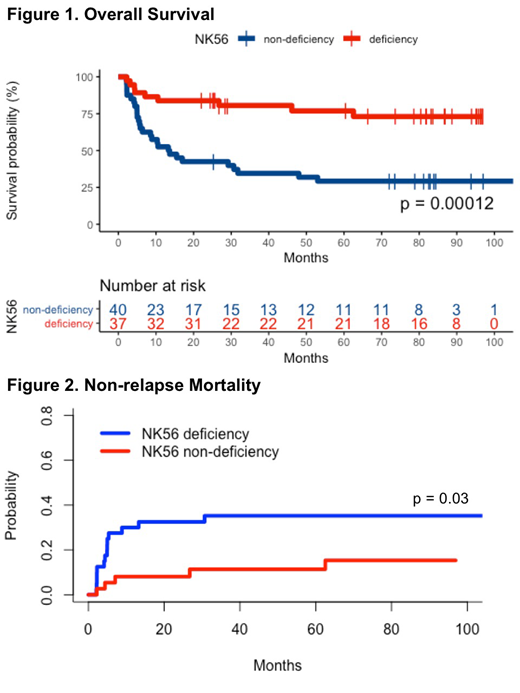Background:Natural Killer Cells are innate immune system cells important in host defenses against viruses and tumor cells. Two subpopulations are well described: NK CD56bright CD16neg (NK56++16-) which is less frequent in peripheral blood (PB) and associated with high cytokine production, and NK56dim16pos (NK56+16+), more frequent in PB and associated with high cytotoxic activity. In allogeneic hematopoietic stem cell transplantation (allo-HSCT), NK cells are important for infection control, and also for the disease control. The mismatch between donor NK cell receptors and host HLA may lead to a stronger graft versus leukemia (GVL), possibly modulating graft versus host disease (GVHD). However, only a few studies evaluated NK subpopulations recovery after HSCT and the impact on transplant outcomes.
Objectives: The aim of the study was to analyze NK cells subpopulations reconstitution after HSCT and their possible impact on HSCT endpoints: relapse, GVHD (acute and chronic), transplantation related mortality and overall survival.
Patients and Methods: Overall, 77 patients from 4 HSCT centers (60 % male, median age 17 years, range 1-74), receiving bone marrow (BM, 47%), umbilical cord (UCB, 30%) or peripheral blood (PB, 23%) from unrelated (80%) or related donors (20%) were studied. The most common diagnosis was acute leukemia (AML 38%, ALL 34%). Most patients received myeloablative conditioning (MAC) regimens (61%). Antithymocyte globulin (ATG) was used in 27 patients (35%) and total body irradiation (TBI) in 40 (52%). Median follow up time was 82 months (22-107). NK subpopulations were quantified by multiparametric flow cytometry at engraftment and days 3, 7, 14, 21 and 60 after engraftment. We have then elaborated graphs plotting cells counts over time (until 60 days) and calculated the area over the curve (AOC) for each subpopulation [NK56++16- (NK56-index) and NK56+16+ cells (NK16-index)], considering 0.5x10e9/L as cut-off value for both subpopulations. A higher AOC represents a more profound NK deficiency. Using receiver operating characteristic (ROC) curves we determined cut offs for the AOC that could provide the best correlation with survival.
Results:The overall survival (OS) in 80 months was significantly worse in patients with NK56 deficiency, defined by a NK56-index > 14592.31 cells/mm3.days (29% x 73% for non- deficient, p=0.0001, Figure 1). NK56 deficient patients also had a higher cumulative incidence (CI) of non-relapse related mortality (NRM: 35% x 15%, p=0.03, Figure 2). GVHD (acute or chronic) was similar between low NK56-index and high NK-56 index patients. In multivariate analysis, high NK56index remained significantly associated with worse OS [hazard ratio (HR) 3.5; 95% confidence interval (95%CI) 1.6-7.6], and higher NRM (HR 2.9; 95%CI 1.0-8.0). There were no significant correlations between NK16-index with any of the analyzed HSCT outcomes.
Conclusion: A higher NK56-index is significantly associated with worse outcome in long term survival and non relapse related mortality in patients submitted to allogeneic hematopoietic stem cell transplantation. This strategy might be helpful in identifying risk groups and possible earlier therapeutic interventions.
No relevant conflicts of interest to declare.
Author notes
Asterisk with author names denotes non-ASH members.


This feature is available to Subscribers Only
Sign In or Create an Account Close Modal